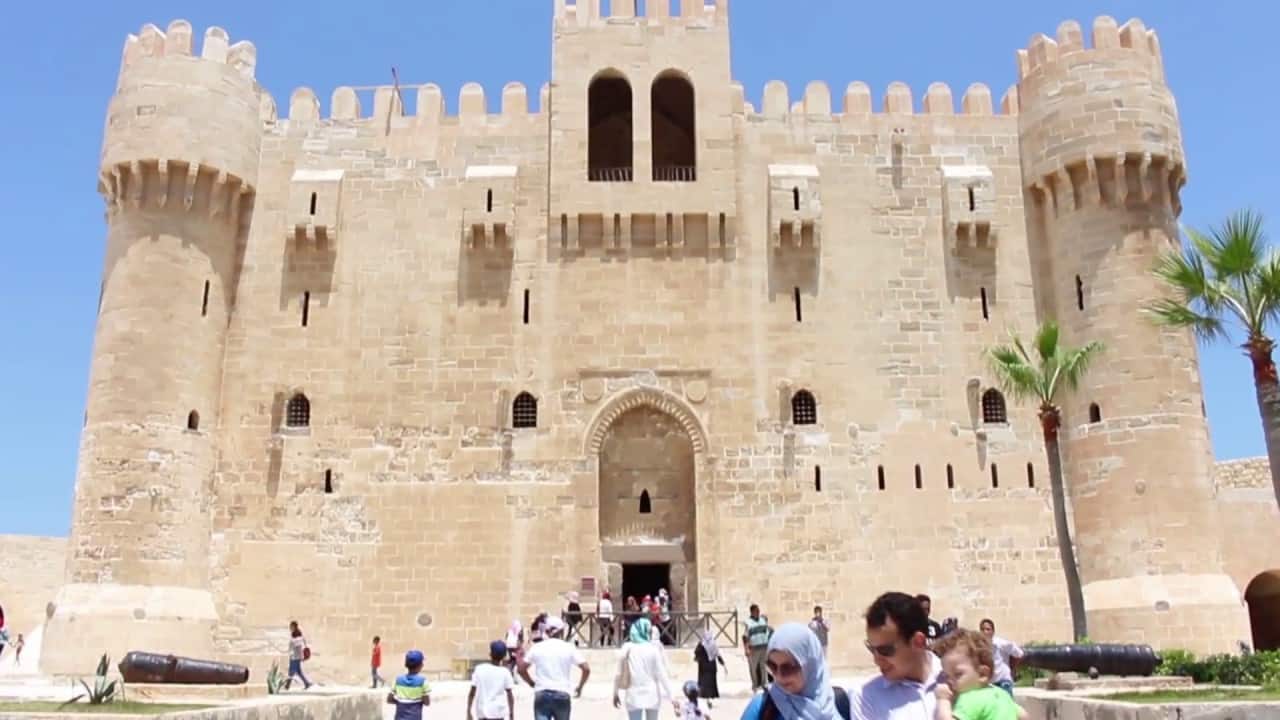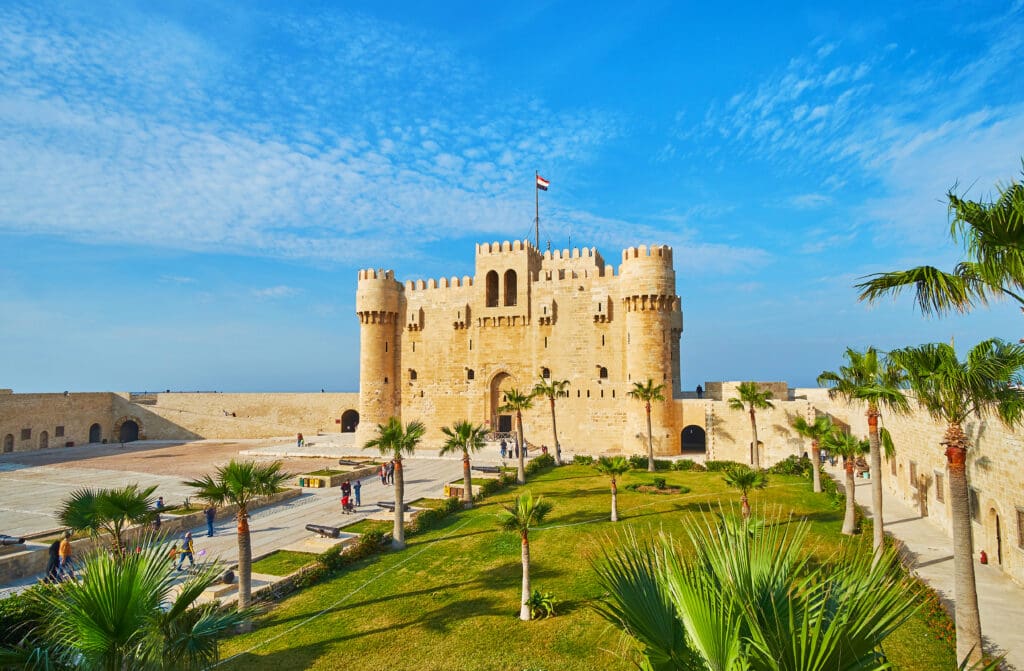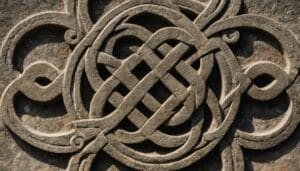Qaitbay Citadel, Alexandria, Egypt

Updated On: April 15, 2024 by Marwa Alaa
The Qaitbay Citadel is a defensive fortress built in the 15th century and located directly on the Mediterranean Sea coast in Alexandria, Egypt. It was established in 1477 CE by Sultan Al-Ashraf Sayf al-Din Qa’it Bay. The Citadel was initially situated on the eastern side of the northern tip of Pharos Island at the mouth of the Eastern Harbour. The Qaitbay Citadel in Alexandria was considered one of Egypt’s most important defensive strongholds and along the Mediterranean Sea coast. It represented an essential part of the fortification system of Alexandria in the 15th century CE.
History and Architecture of the Qaitbay Citadel
It was erected on the site of the famous Lighthouse of Alexandria, one of the Seven Wonders of the Ancient World, and it was built on 17550 m2. About 1480 CE, the Circassian Mamluk Sultan Al-Ashraf Qaitbay fortified the place as part of his coastal defensive edifices against the Turks, who were threatening Egypt then. He built the fortress and placed a mosque inside it. The Qaitbay Citadel continued functioning during most Mamluk, Ottoman, and Modern periods. However, it was kept out of the spotlight after the British bombardment of Alexandria in 1882. It was neglected until the 20th century when it was restored several times by the Egyptian Supreme Council of Antiquities.
The Qaitbay Citadel was built as a defensive fortress designed in a square shape with dimensions 150m x 130m, surrounded by the sea from three directions. The Citadel includes walls, and the central tower on the northeast side is divided into inner and outer walls. The inner walls included the soldier’s barracks and the arms storage, while the outer walls included defensive towers from the four directions. These towers are the same height as the walls except for the Eastern wall, which provides defensive holes for the soldiers.
Founder of the Qaitbay Citadel
The founder of the Qaitbay Citadel is a Circassian Sultan named Al-Ashraf Abou Anasr Saif El-Din Qaitbay El-Jerkasy Al-Zahiry (1468–1496 AD), who was born about 1423 AD (826 AH). He was a Mamluke who had come to Egypt as a young man, less than 20. Bought by Al-Ashraf Bersbay, he remained among his attendants until Al-Ashraf Bersbay died. Then Sultan Djaqmaq bought Qaitbay and later gave him his freedom; Qaitbay then occupied various posts. He became the Chief of the Army during the rule of the Sultan Tamar Bugha. When the Sultan was dethroned, Qaitbay was appointed as a Sultan titled Almalek Al-Ashraf on Monday 26th Ragab, 872 AH (1468 AD). He was one of the most essential and prominent Mamluk Sultans, ruling for about 29 years. He was a brave king who tried to initiate a new era with the Ottomans by exchanging embassies and gifts.
The building of this fort started in the month of Rabi Alawal, 882 AH. Sultan Qaitbay had travelled to Alexandria, accompanied by some other Mameluke princes, to visit the old lighthouse site. During this visit, he ordered the Qaitbay Citadel to be built. In the month of Shaban 884 H, Sultan Qaitbay travelled again to Alexandria when the construction was finished. He provided the fort with a brave legion of soldiers and various weapons. He also dedicated several waqfs, from which he financed the construction works to the soldiers’ salaries. Throughout the Mamluk period, and due to its strategic location, the Qaitbay Citadel was well maintained by all the rulers who came after Qaitbay. It included a large prison made for the princes and the statesmen whom the Sultan kept away from his favour for some reason.
Architectural Splendor
The Qaitbay Citadel is a masterpiece of medieval military architecture characterized by its imposing walls, sturdy bastions, and commanding towers. Constructed using locally sourced limestone and marble, the citadel’s walls rise majestically from the rocky shores of the Mediterranean, creating an imposing silhouette against the azure sky. Its strategic location at Alexandria’s eastern harbour entrance afforded it unparalleled sea views, allowing its defenders to monitor approaching ships and potential adversaries.
At the citadel’s heart lies a central courtyard, surrounded by interconnected chambers, halls, and passageways. The courtyard, once bustling with activity, now serves as a tranquil oasis amidst the hustle and bustle of modern Alexandria. Visitors can wander through the labyrinthine corridors of the citadel, exploring its well-preserved chambers and marvelling at the intricate craftsmanship of its architectural details.
One of the citadel’s most iconic features is its towering central tower, which offers panoramic views of the surrounding landscape and the shimmering waters of the Mediterranean. From the top of the building, visitors can gaze out at the vast expanse of the sea, imagining the countless ships that once sailed through these waters in ages past.
Qaitbay Citadel Over the Years
After the Ottoman Turks had conquered Egypt, they cared for this unique Citadel. They kept it in good condition and stationed it with infantry, artillery, a company of drummers and trumpeters, masons and carpenters. As the Ottoman military weakened, the Qaitbay Citadel lost its military importance. In 1798 CE, during the French expedition of Egypt, it fell into the hands of the French troops, mainly because of the weakness of the Citadel garrison and the power of the French modern weapons at that time.
When Muhammad Ali Pasha became the ruler of Egypt in 1805, he renovated the old Qaitbay Citadel, restoring and repairing its outer ramparts, and he provided the stronghold with the most modern weapons of the period. His reign was like another golden era for the citadel.
The Orabi Revolt happened in 1882, and a large part of Alexandria city was damaged by the British bombardment, especially the site of the citadel. The north and west facades were destroyed, and the citadel was neglected until 1904 when the Ministry of Defense restored the Upper floors. King Farouk wanted to turn the citadel into a palace in 1904, but the Egyptian Navy turned it into a Maritime Museum. The most significant restoration work dates to 1984, when the Egyptian Antiquities Organization made plans to restore the fort.
The National Naval Museum at Qaitbay Citadel
The National Navy Museum inside the citadel contains artefacts from the Roman and Napoleonic sea battles. It combines models, paintings, and statues that portray the development of navigation and shipbuilding in Egypt from Pharaonic times until the present. They also represent the Egyptian naval battles throughout the ages.
The museum was built in 1930 and is considered a relatively small museum; it contains various kinds of fish and sea animals from both the Mediterranean and Red seas, along with other types of fish living in freshwater, like the Nile and the Amazon.
The museum houses a maritime research centre next to the National Institution for Maritime Science in the Qaitbay Citadel plaza. It also has many laboratories, aquariums, and plants from seas and rivers, and it is considered a part of the Maritime Science Institution as it contains many rare fish and sea creatures. In the attached research centre, much research on the creatures from the Egyptian lakes is conducted to try to save sea life.
A small museum is attached to the main museum; it contains models of embalmed sea creatures that live in the Mediterranean Red Sea and the Amazon. It also includes a whale’s skeleton in addition to a mermaid model.
Controversy around the Qaitbay Citadel

A ceremony has raised controversy around the citadel since a wedding party has taken place with the blessing of the Islamic Monuments Department and the supervision of the Tourism Police Department. Activists are enraged by this, saying we can propagate through organizing cultural and intellectual events rather than misuse. They have even suggested using the outside of the citadel for commercial purposes.
A recent controversy is the auction declaring to transform the Citadel Marina into a luxurious café and restaurant. This gesture raised a rage from the public since this was the only free place for the less fortunate to enjoy a summer breeze or go for a walk in the holidays.
Qaitbay Marina
Qaitbay Marina is Alexandria’s most famous and recognizable, probably in Egypt. It bears the memories of the hot sunny days of summer and the rainy days of winter for most Alexandrians.
The famous marina is surrounded by rocks that embrace the waters of the Mediterranean Sea, which the renowned citadel faces. These rocks bear the names of lovers and students who have been on school trips for over a decade. Along the marina, there are chairs for people coming to the citadel to sit and enjoy the sea view and maybe drink something extraordinary, and all this is for free.
Yet, recently, the Central Department of Tourism in Alexandria has declared that the ancient marina will be opened for auction to be developed into a café and restaurant. The area to be opened for auction will start at the gate of the exterior plaza of the Citadel and go to the end of the Marina. This is said to help encourage tourism in Alexandria and reduce the number of street vendors and crime in the area.
Citadel of Qaitbay in Movies
Qaitbay Citadel is a sight to behold and was a perfect movie set for a great action movie about the Crusades. The Crusades, as told by iconic Egyptian director Youssef Chahine and great Egyptian writers Youssef Al-Sebai and Abd Al-Rahman Al-Sharkawy in the iconic historical movie El Naser Salah El-Din (1963), Saladin the Victorious was also ranked among the top 100 films in the history of Egyptian cinema.
When Christians slaughter Muslim pilgrims in the holy lands, Saladin (Ahmed Mazhar) succeeds in taking back Jerusalem under the leadership of Richard the Lionheart of England. The film was shown at the Moscow International Film Festival in 1963. The movie had one blunder: among its various battle scenes are the attack of Richard’s fleet and the Siege of Acre, which Chahine shot near the Citadel of Qaitbay. However, history tells us that the Siege of Acre occurred between 1189 and 1191, while the Citadel of Qaitbay was constructed in 1477.
The best thing about the Qaitbay Citadel of Alexandria is that you will enjoy seeing the actual real place where the archers stood in the old days to defend Alexandria. The structure of the whole place will take the breath away; you will have to pay attention to the inside and ceiling of the entire area.
Visitor Experience
For tourists and history enthusiasts alike, visiting the Qaitbay Citadel offers a captivating journey through the annals of Alexandria’s past. From the moment they set foot within its ancient walls, visitors are transported back to an era of maritime trade, military conquests, and cultural exchange.
Guided tours of the citadel provide insight into its storied history and architectural significance, allowing visitors to explore its labyrinthine chambers and learn about the lives of the people who once inhabited this fortress on the sea. Exhibits within the museum offer a glimpse into Alexandria’s maritime heritage, showcasing artefacts ranging from ancient navigational instruments to intricately carved ship models.
The citadel takes on a magical quality at sunset as the fading light casts a warm glow over its weathered walls and towering towers. From the vantage point of the main building, visitors can witness the sun sinking below the horizon, painting the sky in hues of orange and pink and casting a serene tranquillity over the sea.
Conclusion
In a city steeped in history and culture, the Qaitbay Citadel symbolises Alexandria’s enduring legacy and resilience. From its humble origins as a defensive outpost to its current incarnation as a beloved tourist destination, the citadel has witnessed the rise and fall of empires and the ebb and flow of centuries of human endeavour.
Today, as visitors worldwide flock to its ancient walls, the Qaitbay Citadel inspires awe and admiration, inviting all who venture within to embark on a journey through time and space. The echoes of Alexandria’s past reverberate in its silent halls and echoing corridors, reminding us of this storied city’s timeless allure on the Mediterranean’s shores.






